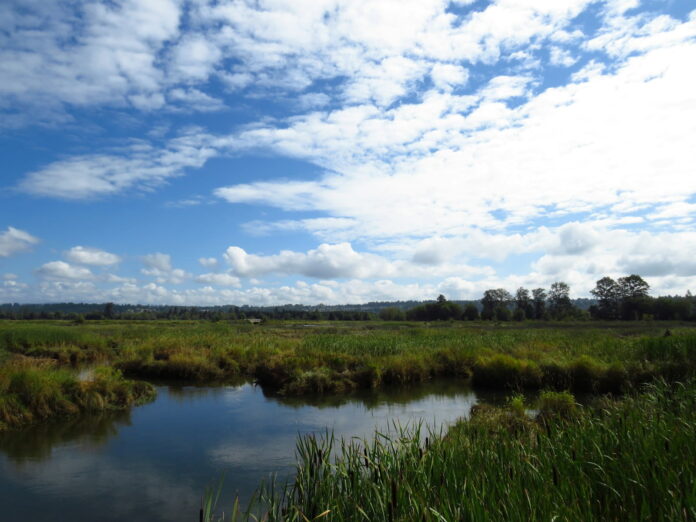Wetlands, often underestimated and undervalued, play a pivotal role in mitigating climate change. These unique ecosystems, characterized by their saturated soils and diverse plant and animal life, serve as natural buffers against environmental fluctuations. This article delves into the multifaceted contributions of wetlands to climate change mitigation, focusing on their function as climate regulators, their capacity for carbon sequestration, and their importance in maintaining biodiversity and ecosystem resilience.
Understanding Wetlands: Nature’s Climate Regulators
Wetlands are areas where water covers the soil or is present near the surface for varying periods of time during the year, including during the growing season. These environments include marshes, swamps, bogs, and fens, each with distinct characteristics but all sharing the common feature of being water-saturated. The hydrology of wetlands is crucial in regulating local and global climates. By absorbing and storing water, wetlands help moderate the impact of floods and droughts, thereby stabilizing weather patterns and protecting surrounding areas from extreme weather events.
Moreover, wetlands act as natural water filters. As water moves through a wetland, it slows down and spreads out, allowing sediments and pollutants to settle. This process not only improves water quality but also reduces the burden on artificial water treatment systems. By maintaining clean water supplies, wetlands support both human populations and wildlife, contributing to overall ecosystem health and resilience.
The cooling effect of wetlands is another significant aspect of their role as climate regulators. The process of evapotranspiration, where water is transferred from land to the atmosphere by evaporation from soil and other surfaces and by transpiration from plants, helps to cool the surrounding air. This natural cooling mechanism can mitigate the urban heat island effect, where urban or metropolitan areas become significantly warmer than their rural surroundings, thereby contributing to climate stability.
Carbon Sequestration: How Wetlands Capture Greenhouse Gases
One of the most critical functions of wetlands in climate change mitigation is their ability to sequester carbon. Wetlands are among the most effective ecosystems for capturing and storing carbon dioxide (CO2) from the atmosphere. The waterlogged conditions of wetlands slow down the decomposition of organic matter, leading to the accumulation of carbon-rich peat soils. This process effectively locks away carbon that would otherwise contribute to the greenhouse effect if released into the atmosphere.
In addition to storing carbon in their soils, wetlands also support vegetation that absorbs CO2 through photosynthesis. Plants in wetlands, such as mangroves, reeds, and sedges, play a vital role in capturing atmospheric carbon and incorporating it into their biomass. When these plants die, their organic matter contributes to the peat layer, further enhancing the carbon storage capacity of the wetland.
However, the destruction or degradation of wetlands can reverse this process, releasing stored carbon back into the atmosphere and exacerbating climate change. Wetland conservation and restoration are therefore essential strategies for maintaining their role as carbon sinks. Protecting these areas from drainage, pollution, and development not only preserves their carbon sequestration capabilities but also ensures their continued contribution to climate regulation.
Biodiversity and Resilience: Wetlands’ Role in Ecosystem Stability
Wetlands are biodiversity hotspots, supporting a wide array of plant and animal species. This biodiversity is crucial for ecosystem stability and resilience, as diverse ecosystems are better able to withstand and recover from disturbances such as climate change. Wetlands provide habitat for numerous species, including many that are rare or endangered. The complex interplay of water, soil, and vegetation creates a variety of niches, supporting a rich tapestry of life.
The resilience of wetlands is also evident in their ability to adapt to changing environmental conditions. Wetlands can absorb excess water during heavy rains and release it during dry periods, thereby maintaining hydrological balance. This adaptive capacity helps buffer ecosystems and human communities against the impacts of climate change, such as increased frequency and intensity of storms and droughts.
Moreover, wetlands contribute to the overall health of the larger landscape. They serve as breeding grounds for fish and other aquatic species, which are vital for both ecological food webs and human economies. The preservation of wetlands thus supports not only local biodiversity but also the broader ecological and economic systems that depend on these species. By maintaining the integrity of wetland ecosystems, we can enhance their resilience and ensure they continue to provide essential services in the face of climate change.
Wetlands are indispensable allies in the fight against climate change. Their roles as climate regulators, carbon sinks, and biodiversity havens underscore the need for their protection and restoration. By valuing and preserving these vital ecosystems, we can harness their natural capabilities to mitigate climate change and promote a sustainable future.
